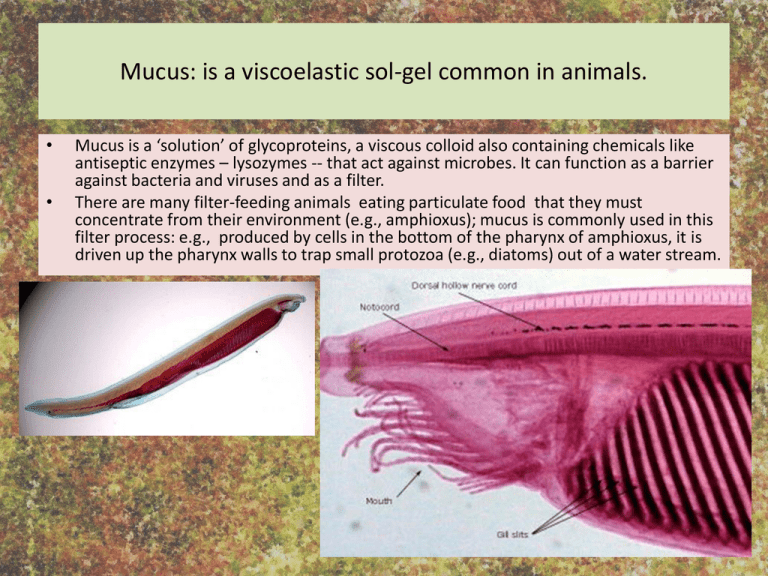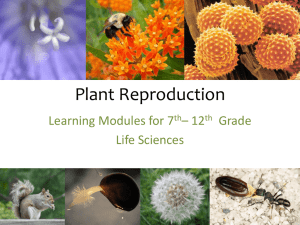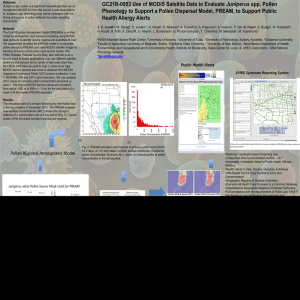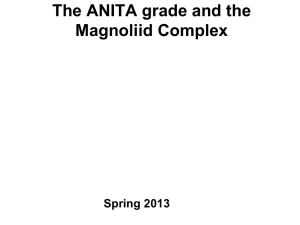Lecture 3
advertisement

Mucus: is a viscoelastic sol-gel common in animals. • • Mucus is a ‘solution’ of glycoproteins, a viscous colloid also containing chemicals like antiseptic enzymes – lysozymes -- that act against microbes. It can function as a barrier against bacteria and viruses and as a filter. There are many filter-feeding animals eating particulate food that they must concentrate from their environment (e.g., amphioxus); mucus is commonly used in this filter process: e.g., produced by cells in the bottom of the pharynx of amphioxus, it is driven up the pharynx walls to trap small protozoa (e.g., diatoms) out of a water stream. Within Phylum Mollusca is the Class Gastropoda, ~35000 species. Pulmonates are a subclass of gastropoda and include land snails; the name refers to their conversion of the mantle cavity into a lung. This gastropod moves on its single foot using “muscular waves moving along [the foot’s] ventral surface”. “the force of these waves is coupled to the substratum by a thin layer of pedal mucus” Denny 1980 There are monotactic and ditactic gastropod species: meaning that in some gastropods the foot is divided into two parallel feet; these ditactic snails still move with pedal waves. A spectacular feature of the damp forests of northwestern coastal NA. Pacific Banana Slug pneumostome: entry to lung See video of pedal waves http://www.flickr.com/photos/turtblu/3424848753 Mucus is critical in the pedal locomotion of Pulmonates Mantle cavity of pulmonates has been converted into a lung: hence ‘pulmonate snails’. of which slugs are just one sort. The edges of mantle cavity seal to the back except for the pneumostome opening; roof of mantle cavity vascularized as a lung for gas exchange. From Wikimedia Commons Arion ater, black slug Denny’s abstract: use the abstract as entry to the paper and read just the parts of the paper that the abstract points to. “Gastropods move using a single appendage – the foot. For many gastropods the power for locomotion is provided by muscular waves moving along the ventral surface of the foot, the force of these waves being coupled to the substratum by a thin layer of pedal mucus. This mucus acts as a glue, allowing the animal to adhere to the substratum on which it crawls. This adhesive ability is advantageous, particularly to animals (such as limpets and certain snails) which live in intertidal or arboreal habitats where the forces of waves and gravity must be resisted while the animal forages. However, the adhesiveness of the pedal mucus presents the animal with a problem. How can an animal with only one foot walk on glue? [Some snails do have nominally 2 ‘feet’.] This question was studied using as an example the terrestrial pulmonate slug, Ariolimax columbianus, and locomotion is found to depend on the unusual mechanical properties of the pedal mucus.” If one is to crawl across a solid surface using body waves you need to obtain purchase. This means gripping the substratum at some location, fixing that spot, so that one gains ground with the wave. If there is no purchase the waves will simply oscillate in situ and there will be no forward progress. from Wikkipedia Wikkipedia Ariolimax columbianus “The yield-heal characteristics of this mucus are ideally suited to the locomotion of A. columbianus. [YIELD: sol; HEAL: gel/glue] During locomotion 12 to 17 muscular waves are present on the slug’s foot; each wave being an area of forward motion, initiated at the posterior end of the animal as the tail is pulled forward. A wave is translated anteriorly until it reaches the head of the animal where it is dissipated as the head moves forward. ...The waves alternate with interwaves, these being stationary relative to the ground. The mucus beneath the leading edge of the interwave quickly heals, and most of the interwave rests on mucus in its solid [gluing] form.” ...the yield-heal cycle of the pedal mucus allows it to act as a material ratchet, facilitating forward movement but resisting backward movement. The result is effective adhesive locomotion.” Many plants are wind pollinated, but many animals, especially insects, serve as pollinators of flowering plants. • Pollen is the way haploid male genetic material moves between flowers of the same species: from the anther of one flower to the stigma of another: this is called cross-pollination. • The most abundant of animals are beetles, so perhaps it is not surprising that beetles are the largest taxon of cross-pollination vectors. • But cross-pollination of flowering plants is also carried out by birds, bees, flies, butterflies, moths and bats. Vector: there are many ‘vectors’, e.g., force vectors, but in this case it means ‘the biotic agent that moves pollen from the male anthers of a flower to the female stigma of a flower to accomplish fertilization’ (Wikki). Bee with pollen baskets loaded. femur tibia auricle basitarsal brush [Posterior] inner face of honeybee hind leg showing basitarsal brush, auricle & rake of pollen press. (Rake teeth are just visible beyond the auricle on the leg’s outer [anterior] surface). Pollen is groomed from branched setae (hairs) of head, thorax and abdomen with other setae (differently shaped), formed as a brush on the enlarged basal tarsal segment. Cross-body use of an opposing leg rakes the pollen from the brush of each hind leg, drawing it up into a specialized segment joint called a pollen press: flexing compacts and squeezes pollen up into the pollen baskets (corbiculae) on the hind leg’s external surface. • • • • Buzz pollination: deliberate mechanical dislodgement of pollen , see recent literature, e.g., Paul DeLuca. Pollen carried on the body in branched hairs and later groomed by leg brushes and compacted into the baskets = corbiculae (outer surface of hind tibia). “From the head and fore parts of the body the pollen grains are cleaned off by the pollen brushes of the front legs, and from the latter they are scraped off upon the broad inner surfaces of the basitarsi of the middle legs. [Monocondylic joints are useful in conferring necessary range of leg grooming movements.] These legs are then grasped one at a time between the brushes of the basitarsi of the hind legs and drawn forward, thus transferring the pollen to the inner (posterior) surfaces of the hind basitarsi. “ POLLEN PRESS : “...the bee brings her hind legs together and moves them alternately up and down. Bu this action the [rake] of the descending legs scrapes a small mass of pollen from the basitarsal brush of the other leg. The pollen detached by the [rake] falls on the surface of the auricle and adheres to it. Then by an upward flexion of the basitarsus on the tibia, the pollen on the auricle, hld in place by the [rake] is pressed up into the lower end of the tibial basket.” • A bee’s body surface (the exoskeleton) is the basis for several external structural adaptations for pollen transport. By contrast, nectar access and transport involves the mouthparts (labium and maxillae, not the mandibles) and a storage chamber within the gut, the crop. Much of the gathered pollen becomes bee food along with the nectar rewards. • • WORD OF THE DAY “Propolis is the resinous gum that bees obtain mostly from th buds of trees and use for stopping cracks or crevices in the hive, and also for strengthening the wax in comb building. Both pollen and propolis are carried to the hive in the baskets of the hind tibiae.” (Snodgrass, p. 108) “a glue or resin-like product elaborated by bees to serve a cement in cases where wax is not sufficiently tenacious” (Torre-Bueno) • Snodgrass, R.E. 1956. Anatomy of the Honey Bee. Comstock, Ithaca, N.Y. Some bat (Chiroptera) species are pollen vectors: they specialize in feeding on nectar and pollen. Compared to insectivorous bats they have reduced dentition and unusually long tongues, often up to 1/3 the length of their body; they hover in flight and lap nectar from flowers. M. Brock Fenton. Just Bats. Univ. of Toronto Press • “Three scanning electron micrographs of the hairs of bats: Geoffroy’s Tailless Bat (GTB) a), Woermann’s Long-tongued Fruit Bat (WLF) b) and a Mexican Bulldog Bat (c). “Note that the scales on the shafts of the hairs of the GTB and WLF bats protrude more than those of the insect-eating bat. Protruding scales in flower-visiting species have been proposed as pollen traps, permitting the bats to carry pollen more efficiently. The similarity of the hairs of the two flower bats is striking, given that they are from different families (a) New World Leaf-nosed bats (b) Old world fruit bats. The hairs are about a tenth of a millimetre in diameter.” [Brock Fenton] • • Convergent evolution - describes similar forms that evolve in different lineages through similar selection pressures. A common ancestor of bats and birds was the first terrestrial quadruped, but then each lineage independently evolved powered flight via adaptations to their homologous forelimbs. They "converged" on a useful trait, forelimb flight: the cladistic term for this is homoplasy: it means ‘similarity of form’. The branched hairs of bees and the erect scales of bat hairs are another example of similarity of form produced in different lineages by similar selection pressures; again, this similarity is not due to homology but by analogous function arrived at independently. light shows the branched hairs of bees bat hais SEM Sensory capacities of animals differ: different sensory modalities are developed: sight, sound, smell: light, mechanical waves, chemicals. • • Katydids and dogs hear ultrasonic sound frequencies . Dogs access a world of smells we cannot. The vision of a hawk circling high is of such superior resolution (fovea: special highdensity of visual receptors) it can see and stoop on mice running on the ground far below. A flowering plant, being under selection to reproduce, must set signals appropriate to the sensory biases of its pollen-carrying vectors. Appropriate signals will be different for nocturnal beetles than hummingbirds. Hummingbirds are particularly sensitive to red and plant species pollinated by hummingbirds set red flowers. In like manner flowers pollinated by bats may use something appropriate to the bat’s acoustic specializations: to its echolocation by ultrasonic sounds. A leaf specialized to attract bat pollinators . Simon R., Holderied M.W., Koch C.U., von Helversen O. 2011. Floral acoustics: conspicuous echoes of a dish-shaped leaf attract bat pollinators. Science 333: 631-633. A bat-pollinated rainforest vine Marcgravia, has evolved a dishshaped leaf (sometimes 2) with the upper concave side facing oncoming bat pollinators. This ‘dish’ reflects back the echoes made by the bat as a ‘echo signature’, localizing the flower within the sensory surround of the bat. Flower shape may be adapted to only allow access by hummingbirds, e.g., long-deep corolla requiring a long thin beak to access nectar. Selection discriminates between the effective pollinator and other species that are less so. Unlike bees, hummingbirds don’t collect pollen; they go for the nectar with specially modified tongues and beaks; but they do pick up pollen and transfer it. From the plant’s point of view its a good thing the bird doesn’t groom as much as bees. Anderson B., Cole W.W., Barrett S.C.H. 2005. Specialized bird perch aids cross-pollination. Nature 435: 41-42. In South Africa a plant, Babiana, is called ‘rat’s tail’ because it grows a “curious sterile infloresence axis”. The function of this plant part is to provide a perch for visiting , and pollinating, sunbirds. The paper by Anderson et al. describes experiments demonstrating perch removal reduces the plant’s fertility. Many animals (beetles, ants, hawkmoths) feed on the pollen and nectar rewards of plants. It is a widespread and critical relationship. bambooweb







